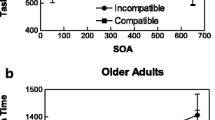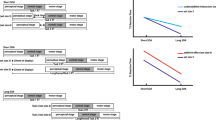Abstract
Two reaction-time experiments using the psychological refractory period paradigm examined whether two prominent tasks, i.e., mental rotation and memory scanning, require access to a single-channel mechanism and must therefore be performed sequentially with other operations requiring the same mechanism. On each trial, subjects made speeded responses to a tone (Exp. 1) or a character (Exp. 2, with symbolic SR-compatibility of the character manipulated) as Task 1 and to a letter (for blocks with mental rotation) or a digit (for blocks with memory scanning) as Task 2. The set-size effect was constant across SOAs, suggesting that memory scanning cannot be performed in parallel with response selection of Task 1. The effect of orientation, however, decreased with decreasing SOA. The decrease was even intensified if Task 1 bottleneck processes were prolonged by symbolic SR-compatibility. The exact pattern of underadditivity, however, was not predicted by current theories of dual-task performance. The results contradict a central bottleneck model but are in line with extensions of the model proposed by Meyer and Kieras.
Similar content being viewed by others
Author information
Authors and Affiliations
Additional information
Received: 21 January 1998 / Accepted: 15 June 1998
Rights and permissions
About this article
Cite this article
Heil, M., Wahl, K. & Herbst, M. Mental rotation, memory scanning, and the central bottleneck. Psychological Research Psychologische Forschung 62, 48–61 (1999). https://doi.org/10.1007/s004260050039
Issue Date:
DOI: https://doi.org/10.1007/s004260050039




